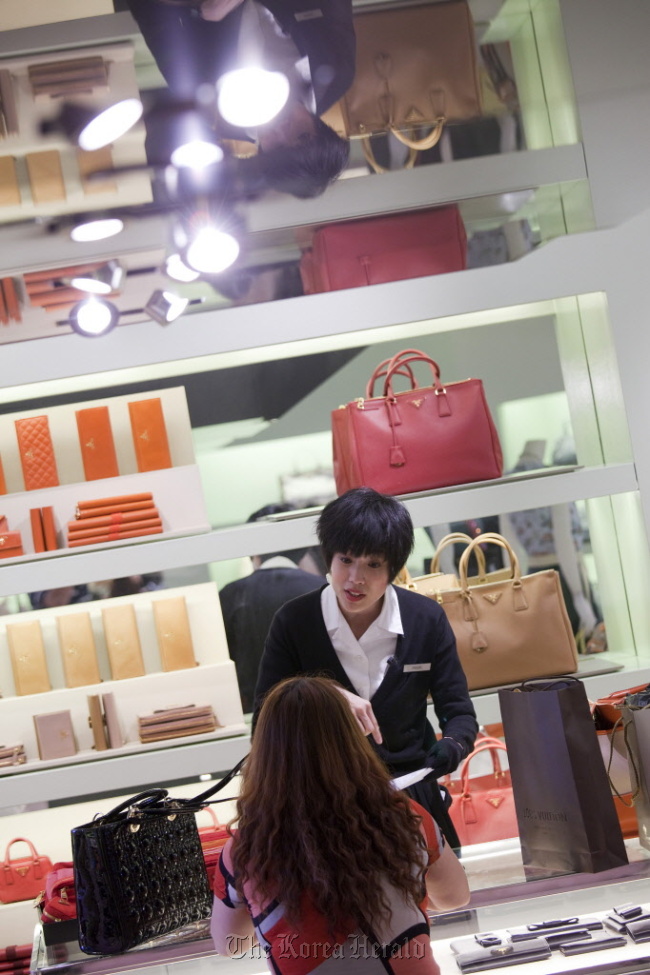China’s slowdown dragged Hong Kong’s retail-sales growth to the weakest pace since 2009 as shoppers visiting from the mainland cut back on purchases of luxury goods such as jewelry and watches.
Sales increased 8.8 percent in May from a year earlier to HK$36 billion ($4.6 billion), the government said on its website Tuesday. That was the smallest gain since September 2009, excluding seasonal distortions each January and February.
The deceleration of Asia’s biggest economy is rippling through Hong Kong, which reported record retail-sales gains as recently as last year, and Macau, where casino revenues are increasing at a reduced pace. A loosening of monetary policy may help China to regain momentum after manufacturing gauges released on July 1 and 2 pointed to a deterioration last month.
 |
A Prada sales assistant attends to a customer in Hong Kong. (Bloomberg) |
“The consumption appetite of mainland visitors has dropped compared with last year because of the economic slowdown,” said Raymond Yeung, a Hong Kong-based economist at Australia and New Zealand Banking Group Ltd. The data “is a warning sign for Hong Kong retailers.”
The increase compared with an 11.4 percent gain in April and the median 9.4 percent estimate in a Bloomberg News survey of seven economists.
Chief Executive Leung Chun-ying, who started his five-year term on July 1, needs to sustain the city’s economic expansion to help fulfill his pledges to help the poor. In Macau, gaming revenue rose 12 percent in June from a year earlier, compared with a 52 percent gain in the same month in 2011, according to data from the Gaming Inspection and Coordination Bureau.
Hitting Bottom
In China, economic growth cooled to 8.1 percent, the slowest pace in almost three years, in the first quarter.
Caroline Mak, chairwoman of the Hong Kong Retail Management Association, said retailers have been offering discounts of as much as 50 percent this summer and slow sales of goods such as furniture indicate weakness in local residents’ consumption, too. Sales growth may be “yet to hit bottom,” Mak said.
Sales of jewelry, watches and clocks rose 3.1 percent in May from a year earlier, the government said. That compared with an increase of 61 percent in the same month in 2011, previously- released data show.
Hong Kong’s government has indicated that an economic growth forecast of 1 percent to 3 percent for this year may be cut as export demand weakens. In China, the government has reduced interest rates and lowered banks’ reserve requirements to fuel the nation’s expansion.
Spending Plans
In Hong Kong, at the Harbour City shopping complex in Tsim Sha Tsui, Zhu Caijuan, 38, said that a slowdown in homebuilding had affected her family’s construction business in Zhejiang, China, and she was “definitely spending less” than during a visit to Hong Kong last year.
At the same time, the strength of the yuan and Hong Kong’s lower tax rates mean that cosmetics and handbags remain attractive, Zhu said, calculating that her family group had spent HK$100,000 in two days.
Visitor arrivals from China slipped to 2.5 million in May from 2.6 million in the previous month, according to the Hong Kong Tourism Board.
“It’s just simple logic that if you have less tourists coming in to buy gold, to buy diamonds, then you would see quite a significantly bad retail-sales figure,” said Lily Lo, a Hong Kong-based economist at DBS Group Holdings Ltd.
Not Splashing Out
Mainland shoppers “are not splashing out as much,” Wong Wai Sheung, chief executive officer of Hong Kong-listed jewelry retailer Luk Fook Holdings (International) Ltd. said at a briefing on June 28. “I’m not too optimistic about the jewelry market this year.”
Luk Fook’s shares have fallen 36 percent this year, compared with a 7 percent gain for the benchmark Hang Seng Index.
Tourists from the mainland have dropped their “exaggerated” spending habits, said Alan Chun, manager of the Gaily Jewellery Co. Ltd. store on Queens Road, Central.
“There aren’t big purchases anymore,” said Chun, referring to diamond and jade products that sell for between HK$100,000 and HK$1 million. “There are still regular ones ― jewelry priced around HK$30,000 that people buy just for fun.”
(Bloomberg)








